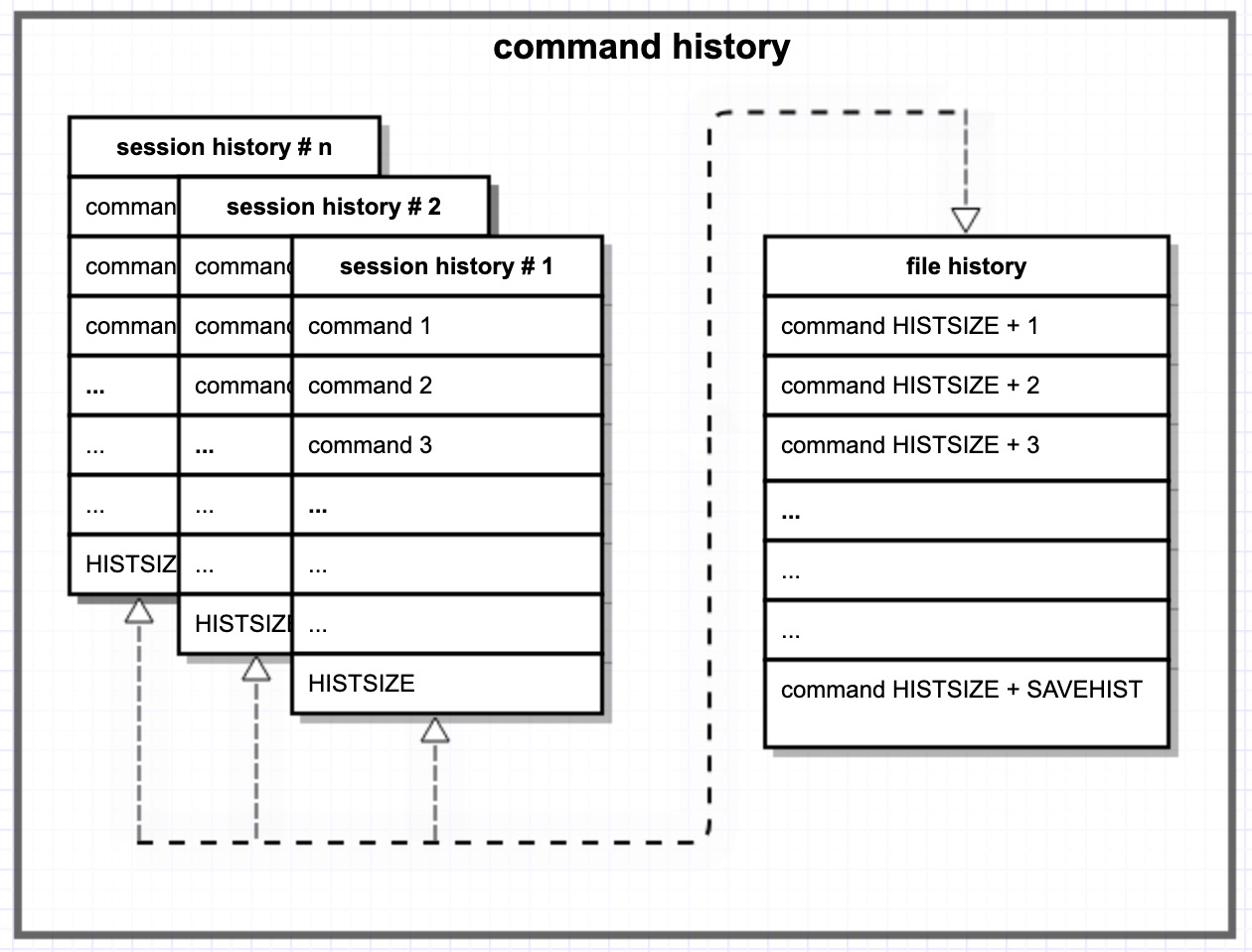This answer assumes the question concerns the behavior of the command history function in zsh.
I feel two points should be made before proposing an answer:
- Information available online for
zsh often refers to a "default configuration". As far as macOS is concerned, the zsh "default configuration" may differ from that described in other sources. The "macOS default configuration" is the zsh "default configuration" as modified by /etc/zshrc. It's best to review this file before making changes, AND all changes should be made in the local user's ~/.zshrc file.
- It helps (me at least) to understand that the shell can maintain two (2) command histories. One is a history file (by default:
~/.zsh_history), the other one is a session history that is cached or retained in memory for each session. The parameters SAVEHIST and HISTSIZE determine the depth of the history file, and the session history, respectively. This can be confusing, and the figure below, while not technically accurate, may help in understanding the concept.
For each session, there is a unique session history. However, there is (by default) only one file history for all sessions. Under the macOS default configuration (ref. /etc/zshrc): HISTSIZE=2000, SAVEHIST=1000. When a new session is started, the session history is empty. However, assuming the file history is not empty, pressing the up arrow key (⬆︎) will reveal commands issued from other sessions. As time goes on - as commands are issued in this new session - its session history will begin filling commands entered in this new session. After, say, 20 commands have been issued, the up arrow (⬆︎) will reveal those 20 commands; the next up arrow key press will reveal the latest entry in the file history.

In summary: In a new session under the macOS default configuration (HISTSIZE=2000, SAVEHIST=1000) your command history is drawn from the history file, which is to say from the session histories of other sessions. As more commands are issued in this new session, these session commands will "push" commands from the history file further down in the stack.
As I understand your question, you do not wish your session histories to co-mingle. That is, for any session, you do not want to see any command history from another session - from the history file. After reading the above, if this is the behavior you want, here is one way to do that:
Proposed Answer: Set SAVEHIST=0 and HISTSIZE=2000
Open the file ~/.zshrc in your editor, and add the following two lines which override the macOS defaults:
SAVEHIST=0
HISTSIZE=2000
SAVEHIST=0 will prevent any session from saving its history to the history file. Each session will have a command history consisting only of its unique session history. The up and down arrow keys (⬆︎, ⬇︎) will never show a command from another session because as far as the current session is concerned, that history does not exist. Potentially undesirable side effects of this option are:
new sessions have no command history
if a session is closed or terminates, command history is lost, but see Note 4 below.
If you tend to keep sessions open for long periods of time (as I do), you could set HISTSIZE to a larger value to postpone "pruning" when the history reaches 120% of its allocation (2,400 commands in this case).
If you wish to retain the history file,zsh provides a large number of options for controlling how the history file and session history are maintained, and how they interact with each other to present your command history. In addition the fc commands are shell built-ins that allow manipulation of the the command history (see also: 1, 2, 3). Beyond the options native to zsh are numerous 3rd party tools dedicated to the command history function - even a tool that stores command history and related tidbits in a relational database. I would summarize by saying, "The shell command history suffers from an embarrassment of riches."
Notes:
Note that the name ~/.zsh_history is not a standard for zsh - it is simply the filename that Apple has chosen.
Apple defines their defaults for zsh in the file /etc/zshrc. It's instructive to review these, but it's probably best to make changes to the defaults within your local configuration file at ~/.zshrc.
HISTFILE, HISTSIZE and SAVEHIST are covered in the zshparam manuals
HISTFILE (from man 1 zshparam)
The file to save the history in when an interactive shell exits. If unset, the history is not saved.
HISTSIZE (from man zshparam)
The maximum number of events stored in the internal history list.
SAVEHIST (from man zshparam)
The maximum number of history events to save in the history file.
The fc commands are shell built-ins that allow manipulation of the the command history (see also: 1, 2, 3).


echo $SHELLorecho $0sharehistory,incappendhistory,histnostore, and the variablesHISTFILEandSAVEHISTare discussed.